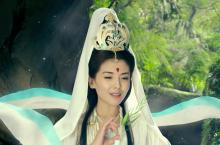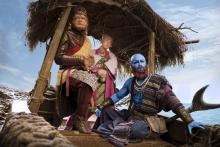By Dr. Craig D. Reid

Chinese film fans have heard of wuxia novels and films, stories soaked in traditional tales and legends of superhuman swordsmen and magical feats. Yet there’s another genre of martial arts prose called gung-fu xiao shuo (kung fu novels), books in which the characters use martial arts even though the heroes are not necessarily from the wuxia setting. One of the most famous kung fu novels, Xi You Ji (Journey to the West), written by the Ming Dynasty’s Wu Cheng-an, circa 1600, is a 100 chapter epic tale about the misadventures of Swuin Wu-kong. Think Homer’s Iliad with animal styles of kung fu.
Though his name is translated as Light of the Meaning of Emptiness, Wu-kong is most commonly known as the Monkey King and is famous for riding around on a golden cloud and fighting with a golden pole magically made from a strand of his hair. Wu-kong is also arguably the most important character in Beijing opera. Accompanied by his kung fu brothers Zhu Ba-jie (a rake-wielding pig) and Xia Wu-jing (a monk’s spade using sand creature), the Monkey King sets out to protect Buddhist Monk Tang San-tsang while he travels to India to collect sacred scriptures.

The literary classic’s first film adaptation, the silent movie Cave of the Silken Web (1927) has led to 60+ films devoted to differing sections of the novel. As film technology has improved, so has the visuals of Wu-kong’s physical and magical abilities, where today’s movies have perhaps surpassed the artistry of what Wu Cheng-an could have imagined.
Since Stephen Chow’s reimagining, Journey to the West: Conquering the Demons (2013), which featured elaborate aerial acrobatics, sharp editing procedures and a flurry of outrageous camera angles that surpassed the antecedents of all adaptations, there has been resurgence of Monkey King related films, where each subsequent yearly rendition has reflected China’s desire to challenge Hollywood grasp on the world’s movie pulse with high budgeted superhero movies where the VFX is becoming more seamless.
In the latest outrageous and engagingly entertaining Wu-kong spectacle The Monkey King 3 (MK3; 2018), the skirmishing stalwart, chimp of Chinese folklore, returns in director Cheang Pou-soi’s fantasy trilogy finale, where as the simian hero scraps with giant scorpions and tackles a jilted pissed off androgynous River God, he’s combatively protecting Zhu, Xia and Tang from a lost Kingdom of Asian Amazons bent on executing them for the island’s most despicable death-penalty crime…being male.

In a nutshell, a true Monkey King trilogy would first cover Monkey’s birth, followed by Monkey becoming human and end with Monkey’s confusion as to why the world didn’t change although he became human. Cheang’s three-parter marginally visits this thematic rendering, yet MK3 delves into the book’s later chapters, which focuses less on Wu-kong’s fantastical martial abilities and more on the Goddess of Mercy Guan Yin testing Tang’s Buddhist path faith on whether when he’s given the choice between loving one woman or loving mankind, does he have the virtuous strength to fulfill his true destiny.

Aaron Kwok returns as the titular character Wu-kong as does the rest of the entourage of Monkey King 2 cast, except that Wu-kong is more fidgety, Ba-jie more human looking, Wu-jing more buffed and Monk Tang more placid. MK3 opens as they’re drifting down a peaceful narrow river guarded by lush green, with Tang’s trusty white stallion in tow on a separate raft. When suddenly they have a run in with the seemingly amiable River God who gets all The Omen on them by using the river as a harrowing weapon against them.
Through sorcery and magical displays of ultra-physical feats the gang narrowly escapes and is some how transported to a lost world known as the Womanland of Western Liang. In Chinese history, the Liang Dynasty (A.D. 502-587) was the first dynasty to have a empress, Empress Zhang. However, since she reigned for only a few weeks, the first official empress was the Tang dynasty’s Wu Ze-tian, who ruled China from 624-705.

While doing a similar Homer Simpson’s barmy fall over a cliff fail, Tang spots a stunning maiden. When their eyes meet, it’s love at first sight. Problem is, the fair maiden is the kingdom’s Queen and males are considered poisonous and thus banned from their land. Upon capture, the Queen’s preceptor and protector convinces the Queen that the male fab four, four musketeers or in this case the four about to dies are now royally screwed. In retro-thought, in the source material, Journey to the West, there’s four companions on this fateful journey, so the choice of having four friends is curious because in Chinese numerology, four is an unlucky number because the words death and four sound alike.
The Queen is struck with the deadliest disease a Womanlander can get…terminal lovesickness. Thus as the Queen and a few of her trusty cohorts help Wu-kong and company to escape, Queen and Tang’s sputtering romance grows and they discover that the only way out of the Kingdom is to flea across the Sea of Suffering and exit through a special gate, where falling in love is the only key that can open the door to freedom.

The battle against the two giant scorpions is rather genius, not so much the special effects, although they’re good, but the creatures look more like the kind of monsters that appeared in old Technicolor movies that featured fights between monsters and humans created by special effects wizard Ray Harryhausen. And that’s beautiful thing because crazily enough, it makes the scorpion’s movements look more fantasy genuine rather than crisp and clean. The fight is also more believable as Wu-kong springs into full fight mode wielding his golden pole like a tornado. When he violently hypno-wheels like the demented Tasmanian devil seen in a Bugs Bunny cartoon, he intermittently blocks the scorpions pincers and venomous stingers, then bashes the arthropods in the nick of time before one of them kills a friend or one of their new female allies.

A reoccurring problem in East and West superhero films, whether the heroes are using weapons or empty hand martial combat, is that you feel the characters aren’t in any real danger. When this happens it’s imperative that the action choreographer makes the fights more visually thrilling for the audience by creating never-before-seen ways the heroes fight and brandish their weapons. In this aspect, MK3 doesn’t disappoint. Yet at the end of the day, we want to see the kind of marvelously choreographed physical fights sequences that Chinese fant-Asia films are famous for, which is also lacking in the finale battle between Wu-kong and the River God whose heart is set on destroying everything and everybody and their pet cat or pig.
As the River God wreaks unfathomable havoc on Womeanland and Wu-kong gives his heart and soul into protecting everyone sacred to him, it’s uplifting and unselfishly altruistic…he’s becoming human. Yet the crux of the film has nothing to do with Wu-kong…the fate of the world hangs in the balance of what Tang’s decision about love and the consequences of choosing one over the other.